
Multifactor authentication is not just for work or school. The extra security comes from the fact that somebody trying to break into your account is probably not using your device, so they'll need to have that second factor to get in. After that you'll just need your primary factor, usually a password, like you do now. Some people worry that multifactor authentication is going to be really inconvenient, but generally it's only used the first time you sign into an app or device, or the first time you sign in after changing your password. You won't have to do the second step very often. Microsoft Authenticator can be used not only for your Microsoft, work, or school accounts, you can also use it to secure your Facebook, Twitter, Google, Amazon, and many other kinds of accounts. And the 6-digit number in Microsoft Authenticator changes every 30 seconds, so even if they knew the number you used to sign in yesterday, they're still locked out. If somebody else tries to sign in as you, however, they'll enter your username and password, and when they get prompted for that second factor they're stuck! Unless they have YOUR smartphone, they have no way of getting that 6-digit number to enter. You open the app on your smartphone, it shows you a unique, dynamically created 6-digit number that you type into the site and you're in. Perhaps you're using the free Microsoft Authenticator app as your second factor. The first time you sign in on a device or app you enter your username and password as usual, then you get prompted to enter your second factor to verify your identity. If that's all you need then anybody who knows your username and password can sign in as you from anywhere in the world!īut if you have multifactor authentication enabled, things get more interesting. Let's say you're going to sign into your work or school account, and you enter your username and password. How does multifactor authentication work? Something you are - Like a fingerprint, or facial recognition.

Something you have - Like a smartphone, or a secure USB key. Something you know - Like a password, or a memorized PIN. The three most common kinds of factors are: For example, a password is one kind of factor, it's a thing you know. A factor in authentication is a way of confirming your identity when you try to sign in.


 0 kommentar(er)
0 kommentar(er)
